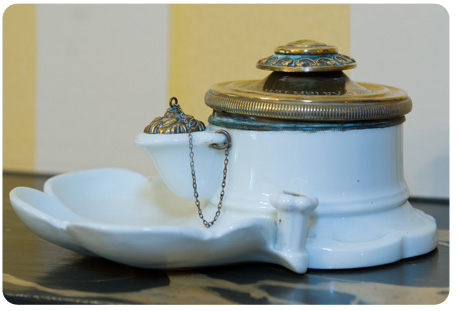Circa 1890
America
Milk glass and brass
Eugene Field House
Descriptive Detail
What is this curious object that looks like a very strange teapot? In the nineteenth century and even in the twentieth century this object was a necessity if you were going to write a letter, a poem, or a book. Even school desks of the time would have one of these built into it, although they would be much plainer than this example. It is an inkwell, a container to hold the ink in which your quill or steel pen was dipped. Topped by an ornate brass lid that is engraved with the words, “To Eugene Field April 7, 1894 from R.W. Walmsley”, the large flared cylinder designed to hold the supply of ink is either translucent milk glass or white porcelain. Attached on the side are three small shallow ‘bowls’ for resting a pen or catching ink drips. A small ‘spout’ with its own decorative cap extends from the rim of the main cylinder and is actually where you would dip the pen. And just to its side is a cylinder in which to store the pen.
Local Historical Connections
Eugene Field’s Life as a poet, satirist, and newspaper reporter undoubtedly prompted this gift. It symbolized the importance of the written word, both for commerce and art. Not only a symbol for Eugene Field and his writing, the inkwell also serves to remind us of Roswell Field, whose writing was so important to history and the Dred Scott case.
National Historical Connections
Early Greeks used a stylus of bone or metal on a wax tablet. The Chinese developed ink by 1200 B.C. Many cultures developed inks from berries, plants, and metals. By 700 A.D. feathers were used for pens. A receptacle for ink became an object of daily use, and along the way it also became a status symbol and a work of art. However, the end of the inkwell began in the 1880s, with the invention of the first practical fountain pen by Lewis Waterman. Not only did Waterman's writing instrument carry its own supply of ink, the flow of the ink was emitted in a regular, controllable stream. As the fountain pen was making its way into everyday life, the inkwell became a lesser part of a large desk set or a novelty item primarily used for decorative purposes.
In 1939, Liszlo Biro, a proofreader from Hungary, patented the first ballpoint pen. Eighteen years later the U.S. Post Office would replace all straight pens and inkwells with the much-improved ballpoint. By the twentieth century, the end of the ink well as a functional and necessary item was inevitable. After centuries of use, the ink well virtually disappeared from daily life.
top^
next artifact}
|

|




